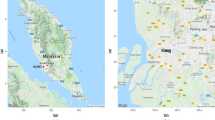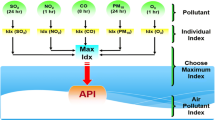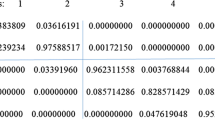Abstract
The duration size of air pollution events refers to a state in which air pollution indices reflect unhealthy conditions over an extended period of time. Thus, a large duration size implies prolonged air pollution events. Such events exert negative effects on human health, disrupt economic activities, and deteriorate environmental ecosystems. This study proposed the use of power-law models as a tool for evaluating the behaviors of duration size for extreme and unhealthy air pollution events. Four different power-law models were used to analyze the air pollution data in Klang, Malaysia. Results indicated that the discrete power-law distribution is a reliable model that could best describe the power-law mechanism existing at the right tail of the data distribution. In parallel with that, air pollution events with duration sizes greater than 33 h are found to reflect the threshold events that demonstrating a power-law behaviors. Findings highlight the need for authorities to be vigilant when air pollution incidents with duration sizes exceeding 33 h occur.





Similar content being viewed by others
Data availability
Due to confidentiality agreements, supporting data can only be made available to bona fide researchers subject to a non-disclosure agreement. Details of the data and how to request access are available from https://www.doe.gov.my/portalv1/en/ at Department of Environment Malaysia.
Code availability
All codes for data analysis associated with this manuscript have been provided as a supplemental material.
References
Achlioptas D, Clauset A, Kempe D, Moore C (2009) On the bias of traceroute sampling: or power-law degree distributions in regular graphs. J ACM 56(4):1–28
Al-Dhurafi NA, Masseran N, Zamzuri ZH, Razali AM (2018a) Modeling unhealthy air pollution index using a peaks-over-threshold method. Environ Eng Sci 35(2):101–110
Al-Dhurafi NA, Masseran N, Zamzuri ZH, Safari MAM (2018b) Modeling the air pollution Index based on its structure and descriptive status. Air Qual Atmos Health 11(2):171–179
AL-Dhurafi NA, Masseran N, Zamzuri ZH (2018) Compositional time series analysis for air pollution index data. Stoch Environ Res Risk Assess 32:2903–2911
Brzezinski M (2015) Power laws in citation distributions: evidence from Scopus. Scientometrics 103:213–228
Clauset A, Young M, Gleditsch KS (2007) On the frequency of severe terrorist events. J Confl Resolut 51(1):58–87
Clauset A, Shalizi CR, Newman MEJ (2009) Power-Law distributions in empirical Data. SIAM Rev 51(4):661–703
Corral Á (2015) Scaling in the timing of extreme events. Chaos Solitons Fractals 74:99–112
Department of Environment (1997) A guide to air pollutant index in Malaysia (API). Kuala Lumpur, Malaysia: Ministry of Science, Technology and the Environment. https://aqicn.org/images/aqi-scales/malaysia-api-guide.pdf
Gabaix X (2016) Power Laws in economics: an introduction. J Econ Perspect 30(1):185–206
Gillespie CS (2015) Fitting heavy tailed distributions: the powerlaw package. J Stat Softw 64(2):1–16
Gillespie C (2020) Powerlaw: analysis of heavy tailed distributions. R Package Version 0.70.6
Google (2019) source: https://maps.googleapis.com/maps/api/geocode/json?address=Klang%2CSelangor&key=xxx
Guzzetti F, Malamud BD, Turcotte DL, Reichenbach P (2002) Power-law correlations of landslide areas in central Italy. Earth Planet Sci Lett 195(3–4):169–183
Janczura J, Weron R (2012) Black swans or dragon-kings? A simple test for deviations from the power law. Eur Phys J Spec Topics 205:79–93
Kam J, Stowers K, Kim S (2019) Monitoring of drought awareness from google trends: a case study of the 2011–17 California Drought. Weather Clim Soc 11(2):419–429
Kidson R, Richards KS (2005) Flood frequency analysis: assumptions and alternatives. Prog Phys Geogr 29(3):392–410
Kravtsov AV, Berlind AA, Wechsler RH, Klypin AA, Gottlöber S, Allgood B, Primack JR (2004) The dark side of the halo occupation distribution. Astrophys J 609:35–49
Liu Z, Wang L, Zhu H (2015) A time–scaling property of air pollution indices: a case study of Shanghai, China. Atmos Pollut Res 6(5):886–892
Malamud BD (2004) Tails of natural hazards. Phys World 17(8):31–35
Malamud BD, Turcotte DL (2006) The applicability of power-law frequency statistics to floods. J Hydrol 322(1–4):168–180
Masseran N (1910) Hussain SI (2020) Copula modelling on the dynamic dependence structure of multiple air pollutant variables. Mathematics 8(11):1–16
Masseran N, Mohd Safari MA (2020) Intensity–duration–frequency approach for risk assessment of air pollution events. J Environ Manage 264(110429):1–10
Masseran N, Safari MAM (2020) Risk assessment of extreme air pollution based on partial duration series: IDF approach. Stoch Env Res Risk Assess 34(3–4):545–559
Masseran N, Razali AM, Ibrahim K, Latif MT (2016) Modeling air quality in main cities of Peninsular Malaysia by using a generalized Pareto model. Environ Monit Assess 188(1):1–12
Mega MS, Allegrini P, Grigolini P, Latora V, Palatella L, Rapisarda A, Vinciguerra S (2003) Power-Law time distribution of large earthquakes. Phys Rev Lett 90(188501):1–4
Moloney NR, Davidsen J (2011) Extreme bursts in the solar wind. Geophys Res Lett 38(L14111):1–4
Mullen RE, Gokhale SS (2005) Software defect rediscoveries: a discrete lognormal model. In: Proceedings - International Symposium on Software Reliability Engineering, ISSRE 2005, 1544735, pp. 203–212
Muller NZ (2016) Power laws and air pollution. Environ Model Assess 21:31–52
Newman MEJ (2006) Power laws, Pareto distributions, and Zipf’s law. Contemp Phys 46:323–351
Nielsen S, Spagnuolo E, Smith SAF, Violay M, Di Toro G, Bistacchi A (2016) Scaling in natural and laboratory earthquakes. Geophys Res Lett 43:1504–1510
Pinto CMA, Lopes AM, Machado JAT (2012) A review of power laws in real life phenomena. Commun Nonlinear Sci Numer Simul 17:3558–3578
Pisarenko VF, Sornette D (2012) Robust statistical tests of Dragon-Kings beyond power law distributions. Eur Phys J Special Topics 205:95–115
Pope CA III, Dockery DW (2006) Health effects of fine particulate air pollution: lines that connect. J Air Waste Manag Assoc 56:709–742
Pope CA III, Brook RD, Burnett RT, Dockery DW (2011) How is cardiovascular disease mortality risk affected by duration and intensity of fine particulate matter exposure? An integration of the epidemiologic evidence. Air Qual Atmos Health 4:5–14
R Core Team (2020) R: A language and environment for statistical computing. R Foundation for Statistical Computing, Vienna, Austria. URL https://www.R-project.org/
Redner S (2005) Citation statistics from 110 years of physical review. Phys Today 58:49–54
Rispoli FJ, Zeng S, Green T, Higbie J (2014) Even birds follow Pareto’s 80–20 rule. Significance 11(1):37–38
Rustomji P, Bennett N, Chiew F (2009) Flood variability east of Australia’s great dividing range. J Hydrol 374:196–208
Safari MAM, Masseran N, Ibrahim K (2019) On the identification of extreme outliers and dragon-kings mechanisms in the upper tail of income distribution. J Appl Stat 46(10):1886–1902
Sen Z, Altunkaynak A (2012) Erdik T (2012) Wind velocity vertical extrapolation by extended Power Law. Adv Meteorol 178623:1–6
Seshadri M, MacHiraju S, Sridharan A, Bolot J, Faloutsos C, Leskove J (2008) Mobile call graphs: beyond power-law and lognormal distributions. In: Proceedings of the ACM SIGKDD International Conference on Knowledge Discovery and Data Mining, pp. 596–604.
Sharma PR (2018) Rainfall flood hazard at nuclear power plants in India. Georisk Assess Manage Risk for Eng Syst Geohazards 12(3):218–233
Sheridan P, Onodera T (2018) A preferential attachment paradox: How preferential attachment combines with growth to produce networks with lognormal in-degree distributions. Sci Rep 8(2811):1–11
Stocker BD, Zscheischler J, Keenan TF, Prentice IC, Seneviratne SI, Peñuelas J (2019) Drought impacts on terrestrial primary production underestimated by satellite monitoring. Nat Geosci 12:264–270
Stringer MJ, Sales-Pardo M, Amaral LAN (2008) Effectiveness of journal ranking schemes as a tool for locating information. PLoS One 3(2):e1683
Teizeira SB (2006) Slope mass movements on rocky sea-cliffs: a power-law distributed natural hazard on the Barlavento Coast, Algarve. Port Cont Shelf Res 26(9):1077–1091
Thelwall M (2016) The discretised lognormal and hooked power law distributions for complete citation data: Best options for modelling and regression. J Informetr 10(2):336–346
Varotsos C, Ondov J, Efstathiouc M (2005) Scaling properties of air pollution in Athens, Greece and Baltimore, Maryland. Atmosc Environ 39(22):4041–4047
Vyushin DI, Kushner PJ (2009) Power-law and long-memory characteristics of the atmospheric general circulation. J Clim 22(11):2890–2904
Acknowledgements
The author is indebted Malaysian Department of Environment for providing air pollution data. This research would not be possible without the sponsorship from the Universiti Kebangsaan Malaysia (grant number FRGS/1/2014/SG04/UKM/03/1 and DIP-2018-038)
Funding
This work is supported by the Universiti Kebangsaan Malaysia [grant number DIP-2018–038].
Author information
Authors and Affiliations
Contributions
The author confirms sole responsibility for the following: study conception and design, data analysis and interpretation of results, and manuscript preparation.
Corresponding author
Ethics declarations
Conflicts of interest
The authors declared no potential conflicts of interest with respect to the research.
Additional information
Publisher's Note
Springer Nature remains neutral with regard to jurisdictional claims in published maps and institutional affiliations.
Supplementary Information
Rights and permissions
About this article
Cite this article
Masseran, N. Power-law behaviors of the duration size of unhealthy air pollution events. Stoch Environ Res Risk Assess 35, 1499–1508 (2021). https://doi.org/10.1007/s00477-021-01978-2
Accepted:
Published:
Issue Date:
DOI: https://doi.org/10.1007/s00477-021-01978-2




